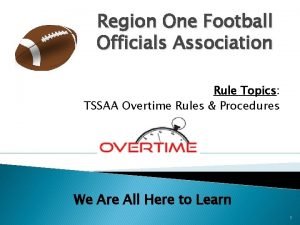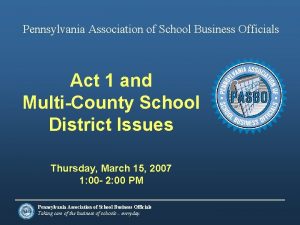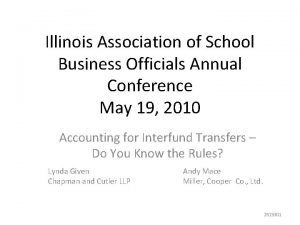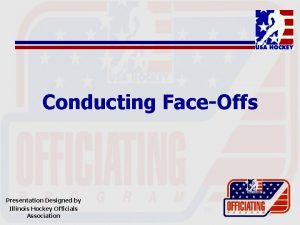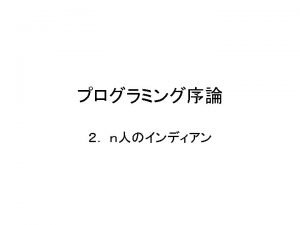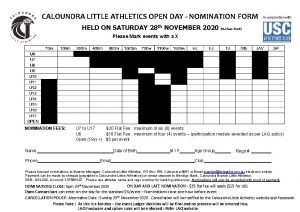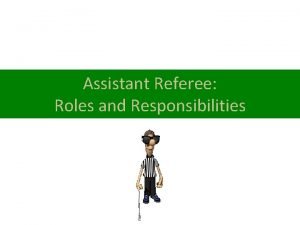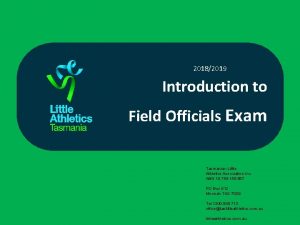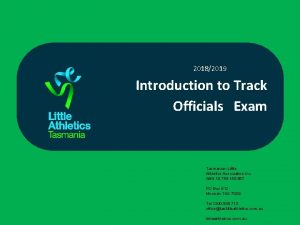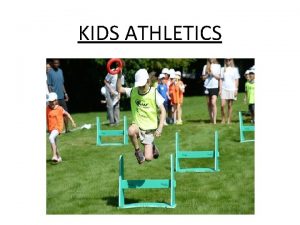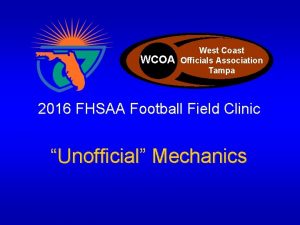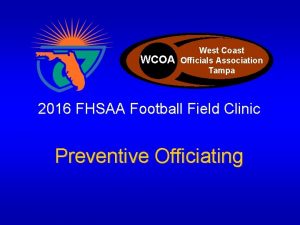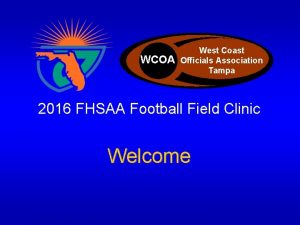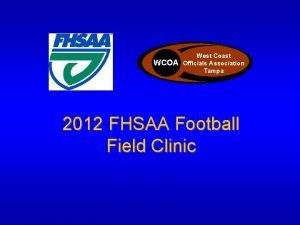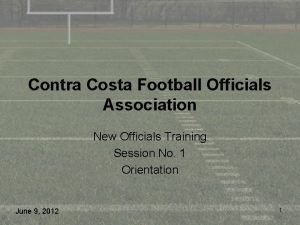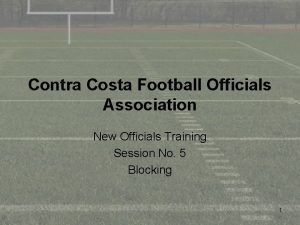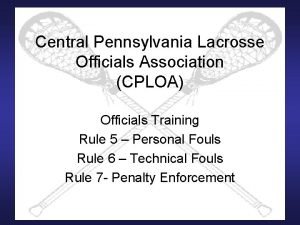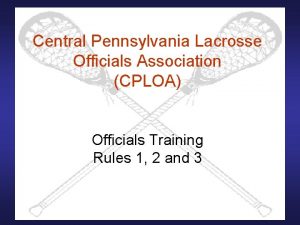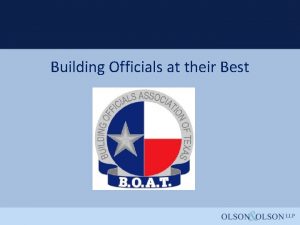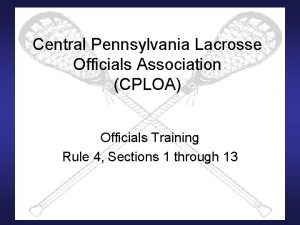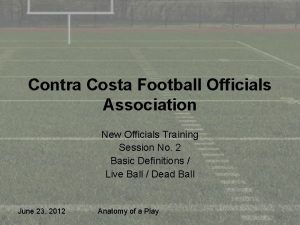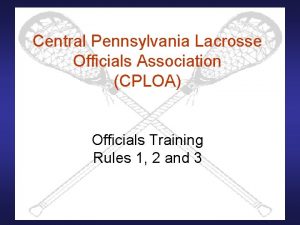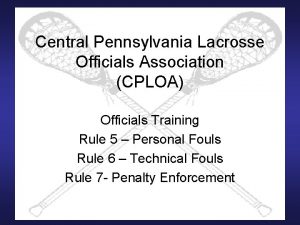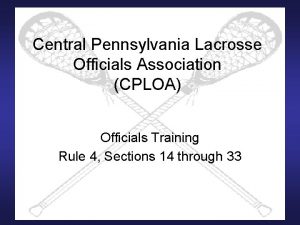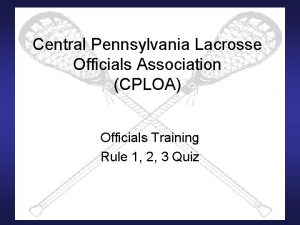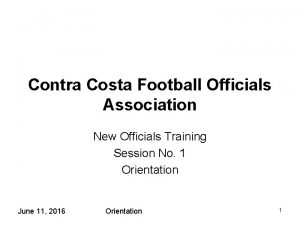20182019 Field Officials Workshop Tasmanian Little Athletics Association








































- Slides: 40

2018/2019 Field Officials Workshop Tasmanian Little Athletics Association Inc. ABN 18 754 156 567 PO Box 812 Moonah TAS 7009 Tel 1300 888 713 office@taslittleathletics. com. au

Important Up Front Stuff!! • https: //athletics. canopihr. com. au/auth/login/? return. Url=%2 F • This is the website to access the online official courses that are mandatory. • These exams are free and you will need to register or log in and complete the following exams for field. • Long Jump, Triple Jump, High Jump, Shot Put, Javelin and Discus. • At the end of each course you will be issued a certificate of completion. Please forward these to the LATas office upon completion.

Recommended • It is recommended you complete Play by the Rules online training – www. playbytherules. net. au – This is free online training and forward your certificate to your education officer. • Resources for officials are available from the TLAA website - including: – Guidelines for Officials – Rules for Competition – Codes of Behaviour

Safety • In the wrong hands or wrong conditions, all events can be dangerous • All officials have a responsibility to ensure site is safe – not slippery, no broken glass, no needles, sharp objects, sand on runway etc • Remember that access and egress must be safe • Observe all throwing area rules and ensure signage is up • Throwing implements must be carried correctly • Competitors and officials must wear enclosed footwear

First Aid • Wellbeing of an athlete is paramount • Pause competition and make area safe • Contact announcer and arrange for first aid to attend

Spectators • Not allowed in the competition area – Only athletes and officials whilst events in progress • Must abide by the Code of Behaviour • Can render a competitor liable to disqualification if: – Offering advice from within the area – Shouting instructions

Coaching Generally • All coaches must have a current Working with Vulnerable People Card • To be undertaken from areas marked by cones or similar • Communication must be in a quiet and discrete fashion • Yelling out across arena even for track events is not preferred • For calling of split times or similar, move to back straight • Do not interfere with conduct of event(s) • Coaching outside these guidelines may render athlete liable to disqualification

Who can coach • Centres with less than 150 members - 2 Centre Coaches • Centres with 150 to 250 members – 3 Centre Coaches • Centres with more than 250 members – 4 Centre Coaches • Centres with Clubs may choose 1 coach per club provided all Clubs suitably represented • Coaches requires ITC Course or Athletics Australia Level 1 or any higher level • Personal coaches must be a AA Level 2 coach

Footwear & Spikes • Appropriate footwear is compulsory – Football boots and cleats not allowed • U 11 & 12’s may wear spikes in events run entirely in lanes as well as long, triple jump, High Jump and javelin • U 13 and above – all track events as well as long, triple and high jumps as well as javelin • In high and long, the sole shall have a max thickness of 13 mm and in high jump the heel shall have a max thickness of 19 mm – Not an issue for all other events

Spike Specifics • Blanks are counted as spikes • spike shoes can be worn outside the defined ‘Field of Play’ if all spikes are suitably covered • Starting blocks on synthetic tracks must be used • 7 mm maximum for synthetic - track • 9 mm maximum for jumps and javelin • 12 mm maximum for grass

Assistance to Athletes • Officials not permitted to coach – This does not extend to factual feedback about a trial such as where an athlete landed • Musical devices, mobile phones or similar devices in competition area is not allowed

Unacceptable Behaviour • Discuss issue with athlete • If this does not work, elevate to Field Referee or Arena Manager • Disqualification may occur – this is not a Chief Official’s call though

Field Events - General • Check proper equipment is being used ie implements, pits etc • Check athletes off and place into trial order eg triple jump mats • Set the Centre record (where appropriate) • Judge in a fair and unbiased manner – For landing point discrepancies, award another trial • Chief Official and Sector Judges use flags • Trial not complete until signalled with a white (or red) flag – Inform athlete of outcome if a foul • Referee can award an obstructed athlete a substitute trial

Field Events - General • Each competitor gets a 30 seconds time allowance – High Jump – (1. 5 mins for 2/3 competitiors left, 3 mins when 1 left) • Record a missed trial or competition rules breakage with a X • Wearing of hat onto runway or into circle is not a foul – Foul recorded only when other rules of competition infringed • For record checks, ensure spike remains in position and call for Arena Manager or Field Referee • Track takes precedence over field • Return equipment to throwing area and ensure recording completed • Extend Best Performances column for TLAA meets but do not place

Field Events - Markers • • One or two markers can be placed onto runway Can be adhesive but nothing that leaves indelible marks Water bottles, hats, clothes etc cannot be used Often athletes will use laminate samples

Completion of Trials • Throws – when athlete leaves circle or runway • Long & Triple – when athlete leaves landing pit – first contact made by foot with the border or ground outside landing area • High jump – when Chief signals fair or foul

Field Events - Ties • All field except high jump: – 2 nd best performance or, if tie remains, third best and so on – Equal placing can be declared • High jump: – Competitor with lowest number of jumps at the height which the tie occurs will be awarded the higher place – If tie still remains then judge on failures – If tie still remains then award same place – there is no jump off for placings

Throws - General • Use certified throwing equipment • At State meets a practice throw is allowed • Five officials (including the Chief) is recommended Chief positioned where implement is thrown One person pulling tape back One person recording, calling and checking for foot fouls Two people in sector – assist with finding landing point and returning implement – Sector judge has final say regarding implement landing – instruct them appropriately !! – –

Throws - General • It is not a foul if an athlete drops an implement and it does not touch the ground outside throwing area • Athlete can retrieve implement and continue within allotted time • If implement goes outside throwing area then it is a foul • Competitor must commence throw from stationary position • Athlete cannot leave circle or runway until implement landed • Leave circle or runway in controlled manner – Towards the rear is preferred

Shot Put Stand on the left hand side for a left hand thrower Ensure appropriate weights are used Shot shall be put from shoulder with one hand only Shot shall touch or be in close proximity to the neck or chin and hand shall not be dropped below this position during the action of putting • Shot shall not be taken behind line of shoulder • Cartwheeling not permitted !! • Shot must fall within inner edges of landing sector • •

Shot Put Implement Age Weight Colour Under 6, 7 1. 0 kg Blue Under 8 1. 5 kg Yellow Under 9, 10, 11, 12 2. 0 kg Orange Under 13, 14, 15 G 3. 0 kg White Under 15 B 4. 0 kg Red

Measuring Shot Put • The zero of the tape is placed on the nearer edge of the mark made by the shot and the tape is taken through the centre of the putting circle. The distance is read from the inside edge of the stop board (or inner edge of the circle). The distance is taken in metres and to the nearest centimetre below the distance put. (Do not round up)

Javelin Weights Under 11, 12, 13 G, 14 G Under 15 G Under 13 B, 14 B Under 15 B 400 grams 500 grams 600 grams 700 grams • Javelins carried in vertical position at all times • Stand on right hand side for right handed thrower and left for left handed thrower • Implement must be held at the grip and thrown over the shoulder or upper part of the throwing arm – Cannot be slung or hurled • Tip of the implement must fall completely within the inner edges of the landing sector • Foul is recorded if athlete, after starting throw, touches lines marking runway, ground outside runway or crosses throwing arc

Vortex and Turbo Jav • • Rules the same as for Javelin Must be thrown by the shaft and land tip first U 6 & U 7 use Vortex U 8, U 9 and 10 use Turbo Jav

Measuring Javelin/Vortex/Turbo Jav • The zero of the tape is placed where the tip of the javelin first struck the ground and the tape is taken through the centre of the circle of which the arc is a part. The distance is read from the inside edge of the arc. The distance is taken in metres and to the nearest centimetre below the distance put. (Do not round up) See image below.

Discus • Extra precautions needed especially when athlete is attempting turns – Everyone (except sector personnel) behind throwing circle and/or off the nets/cage – Chief to judge from outside cage/net • When judging, stand on left hand side for right handed thrower and right hand side for left thrower • Discus must fall within inner edges of landing sector • No rules apply regarding how discus is released • Fair throw if it hits cage/net and lands inside sector

Discus Implement Weights Age Group U 6, U 7 Weight 330 -350 grams U 8, U 9, U 10, U 11 500 grams U 12, U 13 750 grams U 14, U 15 1. 0 kilogram

Measuring Discus • The zero of the tape is placed on the nearer edge of the mark made by the discus and the tape is taken through the centre of the throwing circle. The distance is read from the inside edge of the front of the circle. The distance is taken in metres and to the nearest centimetre equal to or less than the distance thrown. (Do not round up)

Jump Pits • Five officials including Chief recommended – 1 Raker – 1 Spiker – 1 to pull tape through – 1 Recorder • Lay out measuring tape for run way • Practice run up allowed • Take off areas: – Long Jump: • 50 cm from pit for U 6 to U 10 – on a mat covered with sand • 1 or 2 metres for U 11 to U 15 on a white line or a rubber mat with a white line – Triple jump as specified in recording sheet – use witches hat

Jump Pits • • Pit should be raked and levelled after each trial Keep equipment out of pit during trials Ensure run up and landing areas are safe Dampen pit and mat to make measuring easier Position yourself adjacent to take off mat/board Stand on runway whilst pit/map being prepared Once you have raised the white flag, the trial is complete – Even if athlete steps back into pit/landing areas • If athlete falls forward and hand leaves pit area forward from initial break in sand then jump is still fair

Jump Pits • Measurement from the break in the sand nearest to the take off point (regardless of what part of the body makes the mark) to the point of imprint of the athlete’s take off foot nearest the landing point • Use the steel spike and tape measure • Tape should be held horizontally from the level of the take off point and pulled taut back through the take off area over the obtain the correct angle for measurement • Triple Jump mat increments are now 2 metres in TLAA conducted events (i. e. 5, 7, 9 etc. )

Jump Pits - Validity • Triple jump must be a hop, step and jump – Athlete must land on same foot from which they have taken off – In the step they shall land on the other foot from which the jump is performed • Fouls: – Take off foot protrudes over front edge of take off area – Touches ground outside landing area nearer to the take off than the nearest break in the landing area made by the jump – Athletes first contact outside landing area is between take off line and nearest break in sand made on landing – Walking back through landing area without exiting pit correctly – Take off from outside either end of take off area – Somersaulting

Jump Pits - Measurement • U 6 -U 10 (No Triple Jump for U 6 -U 9) – Shortest distance from the nearest break in landing area to imprint made in the sand on the mat – If no imprint in take off area then measure to edge of take off area furthest from landing area (i. e back of the mat) • U 11 -U 15 – Measured as the shortest distance from nearest break in landing area made by any part of body or limbs to front edge of take off area – Taken perpendicular to the take off area or its extension

Triple Jump & Age Groups • Under 6 - 10 no longer offer triple jump at TLAA events • Check take off with athlete and observe • If unsure, seek help from Field Referee or Arena Manager or even Coach (if available and pursuant to earlier provisions) Recommended take off points from pit (guide only) B/G U 11 U 12 U 13 U 14 U 15 Metres 5. 0 6. 0 7. 0

High Jump • Check equipment in place • Use minimum three officials – two for uprights and one for recording/calling • Ensure bag not resting on uprights and ledges face each other • Allow 10 mm clearance between bar and uprights at each end • Set the bar at the correct starting height – Check recording sheet for this – Encourage athletes to clear at least one height whilst encouraging better jumpers to start higher – Starting height should be changed by 1 cm each time event conducted

High Jump • Use measuring stick perpendicular to the ground at lowest point of the cross bar and to top of bar – Bars do bend therefore critical area is in the middle and/or consider rotating and marking the bar for ease of use • Allow competitors the opportunity to check run ups • Field official must check record jumps by setting the bar and re-setting until athlete(s) finished • Passes are recorded with a P • Failed attempt recorded with an X • Successful attempt recorded with a tick

High Jump • If a competitor leaves to compete elsewhere and then returns when bar is at new height then he/she must re-commence at that height – If they have already failed once prior to leaving, then they will only have two attempts at the new height • Increments are 5 cm for Centre/State/Regional meets • State C’ships – 2 cm increments when 3 competitors left • When one competitor is left, he/she can choose increments – Has up to three minutes for each trial (1. 5 mins for 2/3 athletes) • Officials can hold the bar on windy days up until when the athlete takes off

High Jump - Validity • Three successive failures, not necessarily at the same height, will disqualify the athlete from competing further • Competitor must take off from one foot • Fouls: – Knocking bar off supports or touching the ground or landing area beyond the plane of the uprights with any part of the body without clearing the bar – foot excepted if no advantage gained • Don’t penalise athlete if strong wind knocks bar off • Scissor compulsory for all U 8 s to U 10 s – Head must not go over before leading foot – Head not below buttocks when buttocks clear bar – In the act of landing, athlete has made an attempt to get feet down first – Judge athlete as they approach front on

Field Referees • • • Separate referees will be appointed for throws and jumps Ensure that field officials prepare and set up respective areas Ensure rules observed and explained to competitors Decide any technical points Ensure Chief Officials correctly supervise measurements Deal with disputed points Verify records and specifically high jump record attempts Warn or exclude athletes from competition Can change the place of the competition if conditions justify – Only after round is completed unless dangerous in which case round shall be restarted

Questions? ?
 Tasmanian little athletics
Tasmanian little athletics Do or play aerobics
Do or play aerobics West coast officials
West coast officials West coast officials association
West coast officials association West coast officials association
West coast officials association Montana association of school business officials
Montana association of school business officials Colorado association of school business officials
Colorado association of school business officials Mid florida officials association
Mid florida officials association Tssaa overtime rules
Tssaa overtime rules Psoa omaha
Psoa omaha Pennsylvania association of school business officials
Pennsylvania association of school business officials Cploa
Cploa Illinois hockey officials association
Illinois hockey officials association Oregon association of school business officials
Oregon association of school business officials Mississippi association of school business officials
Mississippi association of school business officials Ten little indian boys poem
Ten little indian boys poem 1 little 2 little 3 little indian
1 little 2 little 3 little indian Little athletics caloundra
Little athletics caloundra Taxonomy of tasmanian devil
Taxonomy of tasmanian devil Tasmanian certificate of education
Tasmanian certificate of education Trisico
Trisico Tasmanian devil physiological adaptations
Tasmanian devil physiological adaptations Tasmanian bdm
Tasmanian bdm How is selective breeding accomplished
How is selective breeding accomplished Tasmanian devil behavioral adaptations
Tasmanian devil behavioral adaptations Tasmanian abalone council
Tasmanian abalone council Tasmanian dam case
Tasmanian dam case Project copenheimer
Project copenheimer 21lwuy8i6hw -site:youtube.com
21lwuy8i6hw -site:youtube.com Field dependent vs field independent
Field dependent vs field independent Field dependent vs field independent
Field dependent vs field independent Q factor of capacitor
Q factor of capacitor Waveguide cutoff frequency
Waveguide cutoff frequency Database field types and field properties
Database field types and field properties Field dependent and field independent
Field dependent and field independent Difference between electric field and magnetic field
Difference between electric field and magnetic field 3 man basketball officials coverage
3 man basketball officials coverage Long jump officials and their duties
Long jump officials and their duties Wrestling officials and their duties
Wrestling officials and their duties Florida high school athletic association basketball
Florida high school athletic association basketball Preamble of teachers
Preamble of teachers








